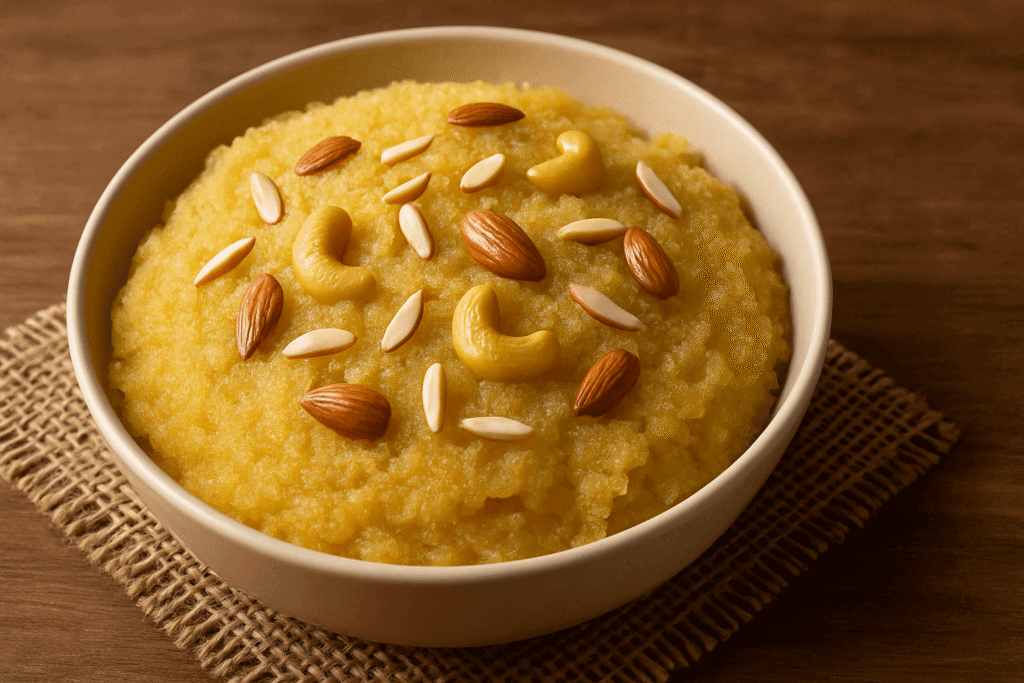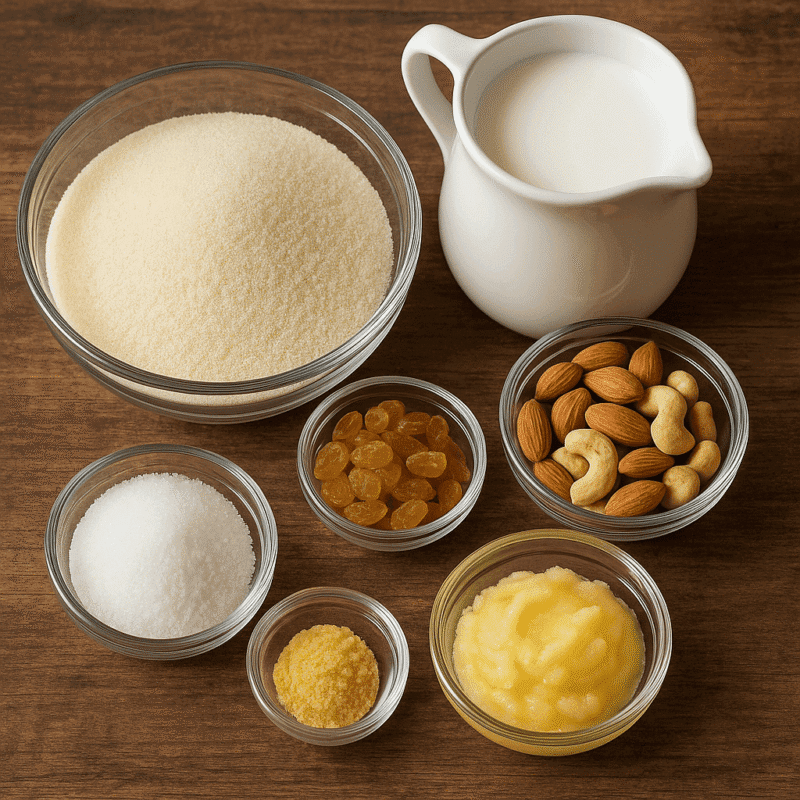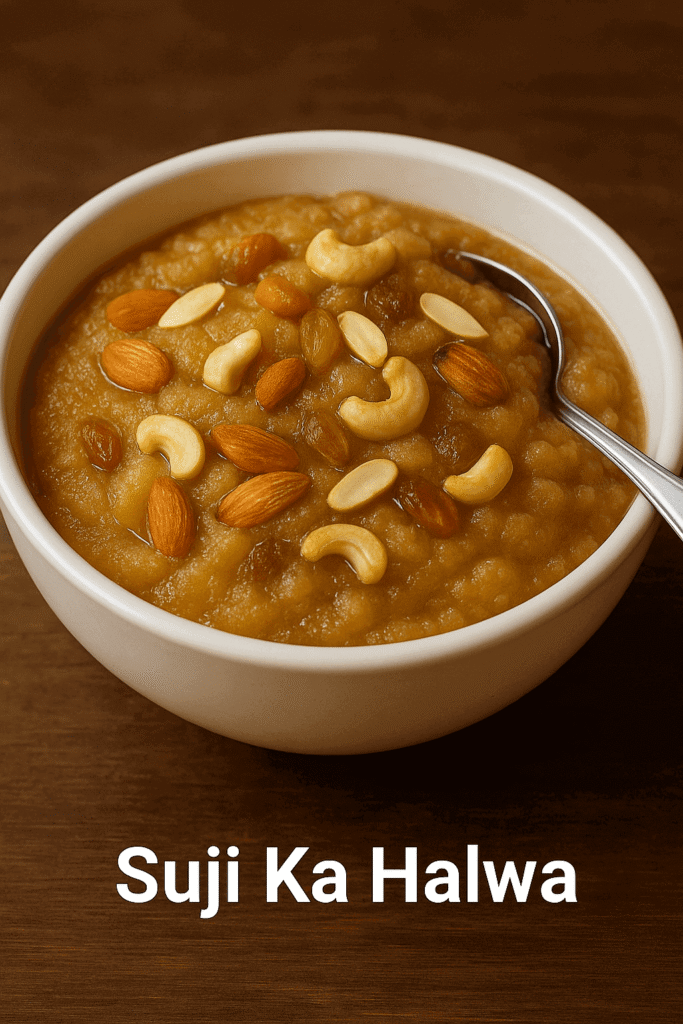
A Childhood Favorite with a Creamy Twist
There’s something about the smell of roasted suji in ghee that instantly transports me back to my childhood. My grandmother used to make suji ka halwa on Sunday mornings, with fresh milk and a lot of love. I remember sitting on the kitchen counter, watching her roast the suji to golden perfection, adding cardamom and finally pouring in warm milk to create the most aromatic and comforting dessert.
This suji ka halwa recipe with milk isn’t just food—it’s an emotion. Whether you’ve had a long day or you’re celebrating something special, this warm bowl of halwa brings you home.
In this blog post, I’ll show you how to make suji ka halwa step by step, with easy-to-understand instructions, simple ingredients, helpful tips, and variations for every kind of sweet tooth. Plus, we’ll talk about suji halwa benefits, calories in suji halwa, and the full suji ka halwa recipe in English.
Table of Contents
Ingredients – What You’ll Need

Dry Ingredients:
- 1 cup suji (semolina/rava)
- ¾ cup sugar (adjust to taste)
- 4 green cardamoms (lightly crushed)
- 6 cashews (split)
- 6 almonds (sliced)
- 5-6 raisins (optional)
Wet Ingredients:
- 2½ to 3 cups full cream milk
- ¼ cup desi ghee (clarified butter)
- A pinch of saffron strands (optional, soaked in 1 tbsp warm milk)
These ingredients make enough halwa to serve 4 people. You can double the recipe for larger gatherings.
How to Make Suji Ka Halwa Recipe with Milk – Step-by-Step
Step 1: Heat the Ghee
In a heavy-bottomed pan or kadai, heat ¼ cup of ghee on medium flame. Let it melt slowly and release its nutty aroma. Always use a thick-bottomed pan to avoid burning.
Step 2: Roast the Nuts
Add the cashews, almonds, and raisins. Fry until:
- Cashews turn golden brown
- Almonds lightly toasted
- Raisins puff up
Remove them and set aside on a plate. This step adds a beautiful crunch and aroma to your suji ka halwa recipe with milk.
Step 3: Roast the Suji
In the same pan, add 1 cup of suji. Stir constantly on low-medium heat. The suji will gradually turn golden and aromatic. This is the most important step—well-roasted suji gives the halwa a rich, nutty flavor.
Roast for about 7–8 minutes. Don’t rush this process. Undercooked suji can ruin the entire dish.
Step 4: Add Crushed Cardamom
Toss in the crushed green cardamom and sauté for another minute. It adds a subtle warmth and traditional flavor to the dish.
Step 5: Add Warm Milk
Now slowly add 2½ to 3 cups of warm milk while stirring continuously to avoid lumps. Be cautious as the mixture may splutter.
This is where the magic happens—the suji absorbs the milk and swells into a smooth, creamy mixture. Your kitchen will smell heavenly at this point!
Step 6: Add Sugar
Once the milk is fully absorbed, add the sugar. Mix well. You’ll notice the mixture will loosen slightly as the sugar melts, which is normal.
Continue cooking on low flame, stirring frequently until the ghee starts to separate from the sides.
Step 7: Add Saffron (Optional)
For extra richness and color, you can add saffron milk at this stage. Stir well.
Step 8: Add Fried Dry Fruits & Serve
Turn off the flame. Garnish with the fried dry fruits you set aside earlier.
Serve hot for best taste and texture. And that’s how to make suji ka halwa with milk, the easy and delicious way.
When to Serve Suji Ka Halwa?
This dish is a superstar on many occasions:
- As a breakfast treat with puris (Indian deep-fried bread)
- During festivals like Navratri, Diwali, or Raksha Bandhan
- As prasad (offering) in religious ceremonies
- Post-dinner dessert for guests or family
- Cold evenings with a cup of chai
- After fasting when your body needs quick energy
Because of its milk base, this version of suji ka halwa recipe with milk is creamier and more filling. Perfect for special moments!
Suji Halwa Benefits
Wondering if suji halwa is good for you? Here are some surprising health benefits:
- Quick source of energy – Ideal for kids, elders, or fasting days
- Good for digestion – Semolina is light and easy on the stomach
- Milk adds protein – Enhances nutritional value
- Ghee supports healthy fats – Great for skin and joints
Of course, moderation is key. But yes, there are definite suji halwa benefits worth enjoying.
The Cultural Significance of Suji Ka Halwa
Suji ka halwa isn’t just a dish—it’s woven into the fabric of Indian rituals, family moments, and festivals.
Halwa in Rituals
In many Indian homes, suji halwa is prepared as an offering to deities during Satyanarayan puja, Navratri, or Ganesh Chaturthi. It’s considered a “satvik” food, meaning pure and suitable for sacred offerings.
As Prasad
Often paired with puri and chana, suji ka halwa becomes the quintessential “halwa-puri” prasad during religious gatherings. It’s both nourishing and symbolic.
Regional Names & Love
From “sheera” in Maharashtra to “rava kesari” in Tamil Nadu, every state adds its own spin—yet the love for this warm, comforting dish is universal.
Variations – Make It Your Own!
1. Kesari Suji Halwa
Add orange food color and extra ghee. Popular in South India. Tastes heavenly when served warm.
2. With Jaggery Instead of Sugar
A healthy, earthy twist. Melt jaggery in warm milk before adding. This version is often made during fasts.
3. Low-Fat Version
Use toned milk and reduce ghee to 2 tbsp. Still tasty, but lighter. Ideal if you’re counting calories in suji halwa.
4. Add Grated Coconut
For a tropical feel and extra texture. A popular addition in coastal regions.
5. Dry Fruit Loaded Halwa
Add pistachios, dates, or walnuts for richer flavor and nutrition.
Common Mistakes to Avoid
- Undercooked suji – It’ll taste raw. Always roast well.
- Lumps in halwa – Stir continuously while adding milk.
- Too thick or dry? – Add a little warm milk to loosen it.
- Burning the suji – Keep flame medium-low and stir often.
- Using cold milk – Can cause lumps. Always use warm milk.
Calories in Suji Halwa (Per Serving)
One small bowl of suji ka halwa with milk contains approximately:
- Calories: 290–320 kcal
- Carbohydrates: 32g
- Protein: 5g
- Fats: 14g
If you’re watching your diet, try smaller portions or a low-fat version. But as a comfort food, it’s totally worth the indulgence!
Suji Ka Halwa Recipe in English – A Global Favorite
This suji ka halwa recipe in English is designed for everyone—beginners, non-Indian readers, and home cooks who want a taste of India without complexity. The dish is known across South Asia but is also loved globally.
From Pakistani kitchens to Indian temples, this dish is more than just food—it’s culture, history, and comfort rolled into one.

FAQs – You Asked, We Answered
Q1: Can I make this halwa without milk?
Yes! Just replace milk with water. But using milk gives it a creamier, richer texture.
Q2: How to make suji ka halwa ahead of time?
Cook as usual, let it cool, and store in an airtight container. Reheat with a splash of milk.
Q3: Is this the same as rava kesari?
They’re similar, but rava kesari often uses food color, extra ghee, and sometimes pineapple or banana for flavor.
Q4: Is suji ka halwa healthy?
In moderation, yes. Thanks to milk and suji, it offers energy, protein, and iron. The suji halwa benefits are especially good for kids and elders.
Q5: Is there an English version of this recipe?
Yes, you’re reading the suji ka halwa recipe in English right here!
Q6: Can I use plant-based milk for vegan halwa?
Yes! Almond milk or oat milk works well. Just swap ghee with coconut oil or vegan butter.
Q7: Can I freeze suji ka halwa?
Absolutely. Store in freezer-safe containers. Thaw overnight and reheat with a splash of milk or water.
Bonus Tip – Leftover Halwa Parfait
If you have leftovers (rare, but it happens!), make a halwa parfait:
- Layer leftover halwa in a small jar
- Add Greek yogurt or whipped cream
- Top with berries or chopped mango
- Chill and serve – it’s heavenly!
Global Adaptations of Suji Halwa
Middle Eastern Influence
Similar to “basbousa,” some Middle Eastern desserts use semolina, ghee, and sugar syrup—proving how widely loved these ingredients are.
Fusion Twist: Halwa Pancakes
Use leftover halwa as pancake filling. Add a spoonful to a crepe or dosa for a sweet surprise.
Halwa Tarts
Press halwa into tart shells, top with cream or fruits. A party-perfect Indo-western dessert.
Halwa Ice Cream
Mix chilled halwa into vanilla ice cream for a fusion dessert that’s creamy, crunchy, and desi at heart.
Final Thoughts
Whether you’re just starting out in the kitchen or you’ve been cooking for years, this suji ka halwa recipe with milk is something anyone can master. It’s simple, comforting, and filled with nostalgic flavors that remind us of home. Every spoonful brings warmth, sweetness, and that familiar homemade goodness we all crave.
Now that you’ve learned how to make suji ka halwa recipe with milk, don’t wait — head to your kitchen and try it out today! Serve it warm, topped with slivered almonds or cashews, and enjoy it with your loved ones. There’s truly nothing like the joy of sharing a freshly made dessert at home.
If you love easy, heartwarming recipes like this, make sure to check out our refreshing margarita recipe — a perfect drink to pair after a sweet treat!
And if this recipe made your day a little sweeter, let us know in the comments below how it turned out for you. We’d love to hear your thoughts and see how your version came out!
Feel free to share this recipe with friends and family — good food is always better when it’s shared.
Bookmark this page so you can come back to it anytime the craving strikes.
Happy cooking and happy eating!

